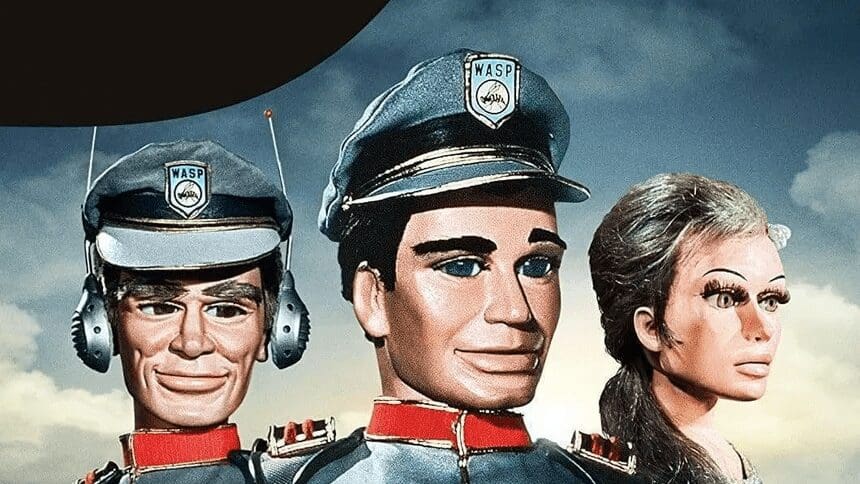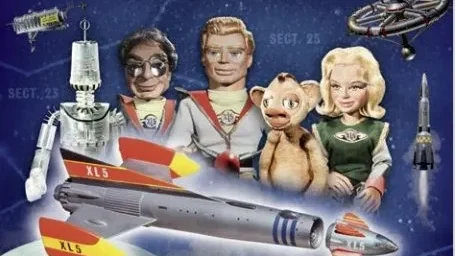
In which The Dark Herald describes the early television efforts of Gerry Anderson. Part one of a three-part series of Gerry Anderson’s productions.
“Stand-by for Action!” A middle-aged voice barks out of the Magnavox TV’s monaural speaker in my family’s living room at 6:30 am.
The Little Dark Herald is rocking back and on the floor in front of the TV, totally standing by for action. He is not disappointed. The ocean explodes for no reason and bongo drums start thundering away while a trumpet blasts out a challenge. Over the next minute and twenty seconds, a submarine launches out of an underwater base, buildings slide into an underground fortress, ICBMs prepare to fire, an oil platform explodes and sinks, rocket fighters roar overhead, a submarine leaps out of the water and a mechanical fish chases it then gets blasted by a torpedo. And that was just the opening credits.
I have made no secret of my less-than-stellar opinion of Gene Roddenberry. His reputation is overblown and largely built on the work of Gene L. Coon. Far from being a creative genius, most of his career was built around recycling OG Star Trek and The Questor Tapes. When all was said and done, Roddenberry kept telling the same stories over and over again. Sometimes he even reused the same dialog. “I am fully functional in every way.” Bleech!
These days it would take all of ten minutes of quality time with the internet to find out what Gene Roddenberry truly was. Yet, even so, you still have guys waxing rhapsodically about Roddenberry’s conservative legacy. I guarantee you that the Great Bird of the Galaxy would be the first one to get on the Woke bandwagon so long as he could have one of his androids having creepy sex with Seven of Nine.
However, there was a husband-and-wife team contemporary with Roddenberry, who produced more and varied science fiction shows than anyone else in that period.
RELATED: NBC Cancels 3rd Season Of Quantum Leap Reboot Starring Raymond Lee
Gerry Anderson started as a photographer with the British Colonial Film Unit shooting documentaries and propaganda films for the British Empire (which was still a thing in 1947). After doing a stint with the RAF he started bouncing around director’s chairs until 1955 when he joined with Arthur Provis to form AP Films, where they produced children’s programming. Torchy the Battery Boy was his first marionette show. *

Torchy the Battery Boy makes for uncomfortable viewing in the 21st century. In the 1950s a lonely old man building a playground in his backyard and inviting children to play there was fine but now… Well, awkward is the kindest word to describe it. Honestly, that word covers the entire show at this point.
Indignant girl’s doll, “You stuffed it inside of me!”
Evil pirate toy singing, “I’m Pongo…The Pirate…I love to pinch and spank!”
And worst of all, “If you give me a kiss, I shall give you my cherry.”
Look, there was a time when The Flintstones sold cigarettes, it was a different world.
While the set design was surprisingly good all things considered, the puppets on the other hand were kind of terrifying

His next project was Four Feather Falls, which was a real-world version of Woody’s Roundup with magic Indian feathers thrown in. Moving on… Quickly.
Anderson was dissatisfied with several aspects of these early productions. Not the least of which was the weak acting of the puppeteers. The fundamental problem is that being a marionettist is a difficult skill set, a lot is going on all at once. Leg, arm, and head movements have to combine to deliver a physical performance, and then on top of that, the marionettist has to do voice acting as well, which is based on an entirely different talent. Getting a puppeteer who could do both well was difficult at best.
Gerry Anderson came up with the idea of separating voice acting from puppetry. The first part of the process was to bring in a voice actor and record his lines. Then while the marionettists were doing their end of things on set, the voice actor’s lines would be fed down a wire into the puppet’s head via an oscillating electric pulse that operated the marionette’s jaw, making it move in time to the syllables. The professional voice work did elevate the performance. He named this process Supermarionation.
RELATED: Tim Kring’s ‘Heroes’ Franchise Set To Get A Reboot With ‘Heroes: Eclipsed’
Anderson for his part was hoping the process would make him something more than just a puppet show producer. He wanted to move into live-action.
The first show where he felt Supermarionation had progressed enough to be usable was called…
SUPERCAR (1961)

I never saw this one when I was a kid because I didn’t exist yet. It was shot in black and white and only had 34 episodes, but it is the first of the real Gerry Anderson shows. The footprints that would lead to Thunderbirds began here.
It was a spy show. The thing you have to understand about the genre of 1960s spy shows is that none of them were intelligence field officers. They were superheroes who had Batman-style gadgets.
Supercar was a spy car taken to its logical extreme. It could fly, dive underwater, and even go into space. It had a team consisting of a test pilot, a scientist, a kid, and a horrifyingly deformed monkey. Although, in truth, all of the puppets were pretty damned ugly. It died prematurely because Gerry Anderson couldn’t get it on an American network, so he decided not to make a second season of it.
RELATED: Alex Kurtzman and Mike McMahan Confirm Star Trek: Lower Decks Will Be Ending This Fall
Where to watch: Currently free on Tubi, and Amazon Prime Video. It’s available on YouTube to some degree, it’s policed but not heavily. DVD boxed sets are easy to find for those who prefer hard media.
FIREBALL XL5 (1962)

I didn’t watch this one either.
Gerry Anderson had divorced his first wife and married his mistress Sylvia by the time this was in production (okay, there were some resemblances to Roddenberry). The truth was he wouldn’t have gotten anywhere near as far as he did without Sylvia. They were an extremely effective power couple. Gerry ran the creative and business side of things, while Sylvia handled anything that required human interaction. This is probably why Fireball was the only one of Gerry Anderson’s shows to ever get on an American network. It wouldn’t have happened without her.
Fireball XL5 was a spaceship that started each of its adventures with an elaborate launch sequence and now that I think of it, all of Gerry Anderson’s shows had an elaborate launch sequence. In a world where there were no video recorders, a popular action scene could be reused every week because an audience never saw them enough to get tired of them.
RELATED: Fans Mock Prime Video’s Fallout “They/Them” Character Dane Of The Brotherhood Of Steel
Supercar had only one model and set. Whereas Fireball expanded the repertoire of the model makers exponentially. There were several models and sets used for this series. And the puppet makers were now fabricating creations that you could look at without shivering in horror. Except for the screeching space monkey, that thing was terrifyingly repulsive in every way imaginable to it.

The exceptional score by Barry Gray made up for the horrible sound of the space monkey. The closing song became something of a novelty hit in the UK.
However, when it became obvious that NBC wasn’t going to renew for a second season, the show’s makers started destroying its models and sets in exciting and dramatic on-camera explosions, including the Fireball XL5 itself. They wanted to move on to their next project, which would be in glorious color. And they would be doing so in a new studio, so there was no need to drag those old models along. All of which would draw a fortune at auction today.
Where to watch: Currently, it’s free on Tubi and Amazon Prime Video. It’s available on YouTube to some degree, it’s policed but not heavily. DVD boxed sets are easy to find for those who prefer hard media.
Stingray (1964)

Again, I wasn’t on Earth when this was first produced but since it was in color it stayed in children’s syndication for-ev-er. Consequently, I did see this one repeatedly.
Gerry and Sylvia Anderson, despite having achieved the highly over-rated goal of getting a show on an American network, were in fairly dire financial straits when Fireball was reaching the end of its run. Fortunately, super-producer Lew Grade had taken it into his head to buy out APFilms. This left the Andersons flush with cash and no longer having to worry about overhead costs.
Stingray was the name of the show’s real star, a nuclear-powered submarine capable of making 600 knots and reaching depths of 7 miles deep, just barely reaching the bottom of the Mariana Trench, the deepest part of the ocean on Earth.
It turned out that the oceans were well populated with advanced civilizations (it was the sixties, and while undiscovered underwater civilizations were highly unlikely it was not yet viewed as completely impossible). Some of these sea-sapients were nice enough, but others, like King Titan of Titanica, wanted to destroy all of the surface dwellers. This had nothing to do with pollution, he just wanted to do it out of general evilness (again it was the sixties).
On his first mission as Captain of Stingray, Captain Troy Tempest and his loyal crew of one get captured by Titan who promptly sentences him to death (Swift One Tempest). However, they are rescued by Titan’s beautiful slave Marina, who escapes with them and joins Stingray’s crew.
There was a surprising, (if accidental), amount of representation, Commander Shore of WASP was a paraplegic, (it saved on puppetry) and the beautiful Marina was mute (the Sixties perfect woman jokes wrote themselves). Although Marina could also breathe water which I guess made up for the mute thing. The Sixties were a different world.

Speaking Sixties world, M’s secretary from the Bond movies, Lois Maxwell voiced Commander Shore’s daughter Atlanta. Her job was to be jealous of Marina.
Barry Gray’s score for this show was quite possibly the best of his career. Certainly, the Andersons thought so, they reused Stingray’s music constantly for the next ten years.
The stories were a combination of sixties spy show meets Edgar Rice Burroughs. The stories weren’t so much ‘better than you’d think’ as ‘better than they had any right to be.’
As good as Stingray was, it failed in one key area. No American network sale. Again. So far as the Andersons were concerned, the only purpose for any of his shows was to get picked up in the US and collect the big bucks. If a show didn’t do that, he dropped it and moved on.
Their next series would be their best-known work. The Thunderbirds.
Where to watch: Currently free on Tubi and Amazon Prime Video (with commercials). It’s available on YouTube to some degree, it’s policed but not heavily. DVD boxed sets are easy to find for those who prefer hard media.
(End of Part One)
Do you have a favorite Gerry Anderson show or a particular episode you like, or is this the first you have heard of him? Let us know in the comments!

As a kid in Newburgh, NY during the early 70s, I was taken to see a matinee showing of Thunderbirds are Go, but what I really looked forward to was seeing UFO on television. God, I loved the Skydiver submarine and Sky One.
@Rob
Gerry Andersons live action years will be the next series.
My favorite Supermarionation shows were Stingray, The Thunderbirds and Captain Scarlet.